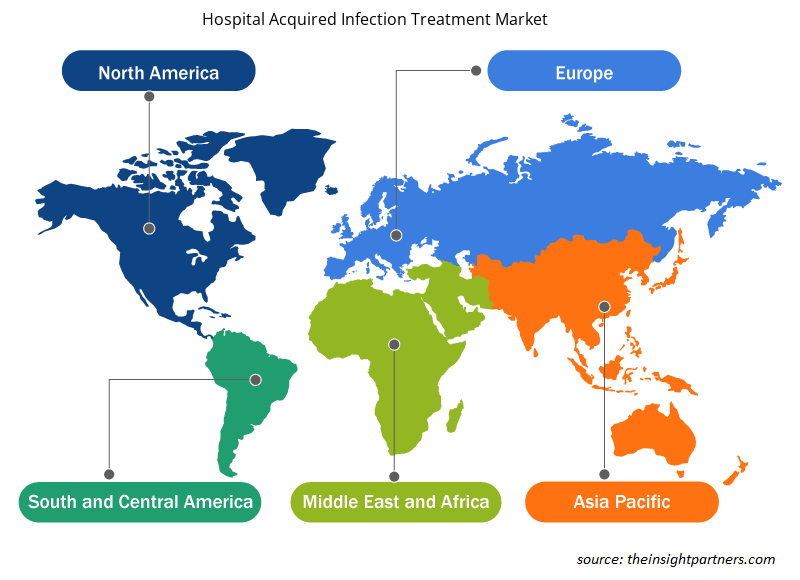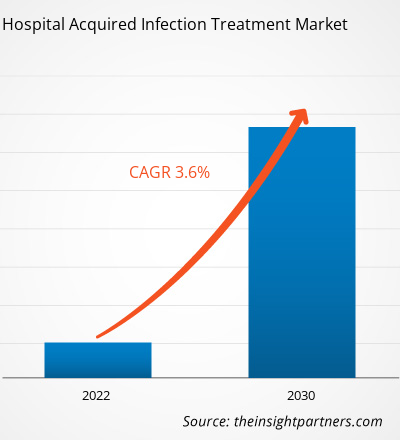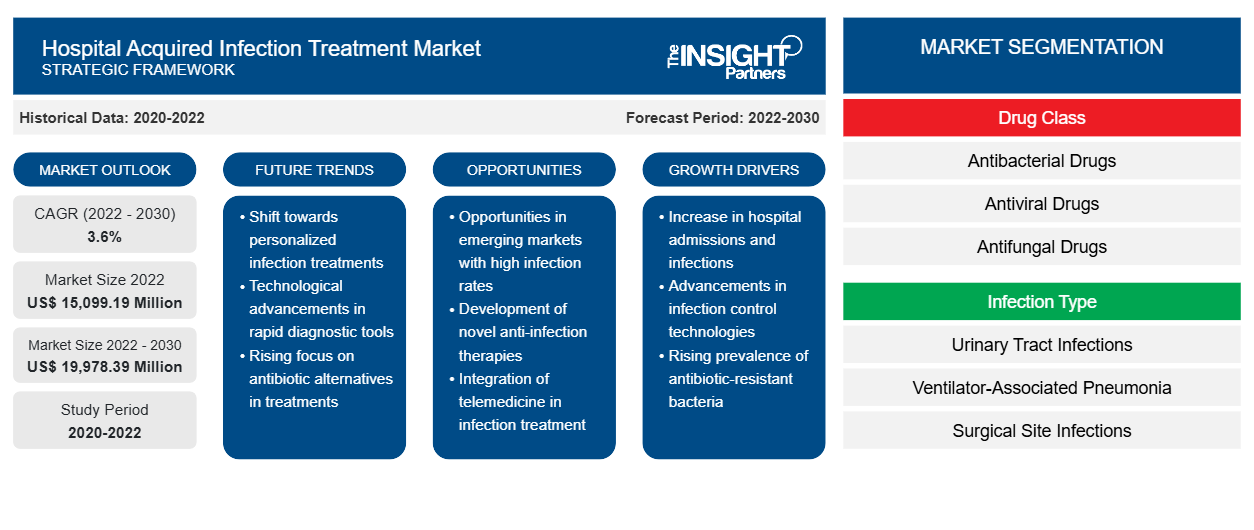[Informe de investigación] Se espera que el mercado de tratamiento de infecciones adquiridas en hospitales crezca de US$ 15.099,19 millones en 2022 a US$ 19.978,39 millones en 2030; se anticipa que registre una CAGR del 3,6% entre 2022 y 2030.
Perspectivas del mercado y opinión de analistas:
Las infecciones adquiridas en el hospital (IAH), también conocidas como infecciones adquiridas nosocomialmente, pueden desarrollarse en una variedad de entornos, incluidos hospitales, instituciones de atención a largo plazo y entornos ambulatorios, y también pueden aparecer después del alta. Las IAH también pueden involucrar infecciones ocupacionales que afectan a los trabajadores de la salud. Los factores clave que impulsan el crecimiento del mercado de tratamiento de infecciones adquiridas en el hospital son la alta prevalencia de IAH y el creciente enfoque en la seguridad del paciente y la atención de calidad. Sin embargo, la amenaza de la resistencia a los antimicrobianos obstaculiza el crecimiento del mercado de tratamiento de infecciones adquiridas en el hospital .
Factores impulsores y restricciones del crecimiento:
Las infecciones del torrente sanguíneo asociadas a la vía central, las infecciones del tracto urinario asociadas al catéter y la neumonía asociada al respirador son algunos ejemplos de infecciones asociadas a la atención médica (IAAS). Estas infecciones, conocidas como infecciones del sitio quirúrgico, también pueden surgir en sitios quirúrgicos. Según el informe de los Centros para el Control y la Prevención de Enfermedades (CDC) “Informe de progreso nacional y estatal de 2020 sobre infecciones asociadas a la atención médica”, publicado en 2021, los casos de infecciones del torrente sanguíneo asociadas a la vía central, bacteriemia por Staphylococcus aureus resistente a la meticilina (SARM) y eventos asociados al respirador aumentaron un 24 %, 35 % y 15 %, respectivamente, en los EE. UU. entre 2019 y 2020.
Además, según el informe de enero de 2022 de la Red Nacional de Seguridad Sanitaria (NHSN), las infecciones del tracto urinario (ITU) son el quinto tipo más común de infección asociada a la atención médica. Las ITU representan más del 9,5% de las afecciones hospitalarias de cuidados agudos. La infección del tracto urinario asociada al catéter (ITUA) es causada por catéteres urinarios utilizados para drenar la orina de la vejiga. La ITUA es una de las infecciones más frecuentes entre los pacientes con ITU hospitalizados. Según los Centros para el Control y la Prevención de Enfermedades (CDC), casi el 75% de las infecciones están relacionadas con un catéter urinario. Durante sus estadías en el hospital, entre el 15% y el 25% de los pacientes hospitalizados necesitan usar catéteres urinarios. El uso prolongado del catéter urinario es el factor de riesgo más importante para contraer ITUA. Las complicaciones de la ITUA implican sufrimiento del paciente, estadías hospitalarias prolongadas, mayores costos de tratamiento e incluso la muerte.
Además, según los CDC, las infecciones urinarias son responsables de más de 13.000 muertes cada año. La cistitis aguda sin complicaciones causa alrededor de seis días de malestar, lo que da lugar a aproximadamente 7 millones de visitas al consultorio cada año con un costo de 1.600 millones de dólares. Como resultado, el creciente número de casos de infecciones asociadas a la atención sanitaria supone una carga financiera significativa para el sistema de atención sanitaria. La creciente prevalencia de las infecciones urinarias asociadas a la atención sanitaria, combinada con la mayor demanda de medicamentos para su tratamiento, está impulsando el mercado.
Sin embargo, la resistencia a los antimicrobianos plantea un desafío importante para el tratamiento de las infecciones asociadas a la atención médica, ya que limita la eficacia de los agentes antimicrobianos existentes y requiere el desarrollo de nuevas estrategias de tratamiento y alternativas antimicrobianas para combatir eficazmente los patógenos resistentes.
Personalice este informe según sus necesidades
Obtendrá personalización en cualquier informe, sin cargo, incluidas partes de este informe o análisis a nivel de país, paquete de datos de Excel, así como también grandes ofertas y descuentos para empresas emergentes y universidades.
-
Obtenga las principales tendencias clave del mercado de este informe.Esta muestra GRATUITA incluirá análisis de datos, desde tendencias del mercado hasta estimaciones y pronósticos.
Segmentación y alcance del informe:
El mercado global de tratamiento de infecciones adquiridas en hospitales está segmentado en función de la clase de fármaco, el tipo de infección y el canal de distribución. Según la clase de fármaco, el mercado de tratamiento de infecciones adquiridas en hospitales se segmenta en fármacos antibacterianos, antivirales , antimicóticos y otros. Según el tipo de infección, el tratamiento de infecciones adquiridas en hospitales se diferencia en infecciones del tracto urinario, neumonía asociada al respirador, infecciones del sitio quirúrgico, infecciones del torrente sanguíneo y otras infecciones hospitalarias. Según el canal de distribución, el mercado se segmenta en farmacias hospitalarias, farmacias minoristas, comercio electrónico y otros. El mercado de tratamiento de infecciones adquiridas en hospitales, según la geografía, se segmenta en América del Norte (EE. UU., Canadá y México), Europa (Alemania, Francia, Italia, Reino Unido, Rusia y el resto de Europa), Asia Pacífico (Australia, China, Japón, India, Corea del Sur y el resto de Asia Pacífico), Oriente Medio y África (Sudáfrica, Arabia Saudita, Emiratos Árabes Unidos y el resto de Oriente Medio y África) y América del Sur y Central (Brasil, Argentina y el resto de América del Sur y Central).
Análisis segmental:
El mercado de tratamiento de infecciones adquirido en hospitales, por clase de medicamento, está segmentado en medicamentos antibacterianos, antivirales, antimicóticos y otros. El segmento de medicamentos antibacterianos tuvo la mayor participación de mercado en 2022 y se prevé que registre la CAGR más alta durante 2022-2030.
El mercado de tratamiento de infecciones adquiridas en el hospital, por tipo de infección, se segmenta en infecciones del tracto urinario , neumonía asociada al respirador, infecciones del sitio quirúrgico, infecciones del torrente sanguíneo y otras infecciones hospitalarias. El segmento de infecciones del tracto urinario tuvo la mayor participación de mercado en 2022. Sin embargo, se prevé que el segmento de neumonía asociada al respirador registre la CAGR más alta entre 2022 y 2030.
El mercado de tratamiento de infecciones adquirido en hospitales, por canal de distribución, está segmentado en farmacias hospitalarias, farmacias minoristas, comercio electrónico y otros. En 2022, el segmento de farmacias hospitalarias tuvo la mayor participación de mercado y se prevé que el mismo segmento registre la CAGR más alta durante 2022-2030.
Análisis regional:
Según la geografía, el mercado mundial de tratamiento de infecciones adquiridas en hospitales está segmentado en cinco regiones clave: América del Norte, Europa, Asia Pacífico, América del Sur y Central, y Medio Oriente y África.
En 2022, América del Norte tenía la mayor participación en el tamaño del mercado mundial de tratamiento de infecciones adquiridas en hospitales. Estados Unidos tiene una alta prevalencia de HAI, lo que impulsa el crecimiento del mercado de tratamiento de infecciones adquiridas en hospitales. Según los CDC, en un día cualquiera, aproximadamente 1 de cada 31 pacientes hospitalizados tiene al menos una HAI. De manera similar, según la Oficina de Prevención de Enfermedades y Promoción de la Salud, las HAI y otras infecciones pueden provocar sepsis y causan aproximadamente 1,7 millones de casos de enfermedad y 270.000 muertes por año en los EE. UU. Por lo tanto, la alta prevalencia de HAI entre las personas en los EE. UU. impulsa el crecimiento del mercado de tratamiento de infecciones adquiridas en hospitales.
Desarrollos industriales y oportunidades futuras:
A continuación se enumeran varias iniciativas adoptadas por los actores clave que operan en el mercado mundial de tratamiento de infecciones adquiridas en hospitales:
- En mayo de 2023, Innoviva Specialty Therapeutics anunció que la Administración de Alimentos y Medicamentos de los Estados Unidos (FDA) había aprobado XACDURO (sulbactam inyectable; durlobactam inyectable), envasada conjuntamente para uso intravenoso en pacientes de 18 años o más para el tratamiento de la neumonía bacteriana adquirida en el hospital y la neumonía bacteriana asociada al respirador (HABP/VABP) causada por cepas susceptibles del complejo Acinetobacter baumannii-calcoaceticus (Acinetobacter). Innoviva Specialty Therapeutics afirmó que se centra en ofrecer terapias innovadoras en cuidados críticos y enfermedades infecciosas.
- En mayo de 2023, investigadores del Instituto Indio de Educación e Investigación Científica (IISER), Pune y el Instituto Central de Investigación de Medicamentos (CSIR-CDRI), Lucknow anunciaron que habían descubierto un nuevo antibiótico potencial contra Acinetobacter baumannii, que con frecuencia causa infecciones asociadas a la atención médica.
- En septiembre de 2020, Shionogi & Co Ltd anunció que la FDA había aprobado una solicitud complementaria de nuevo fármaco (sNDA) para FETROJA (cefiderocol) para el tratamiento de pacientes de 18 años o más con neumonía bacteriana adquirida en el hospital y neumonía bacteriana asociada al respirador (HABP/VABP) causada por microorganismos gramnegativos susceptibles como el complejo Enterobacter cloacae, Klebsiella pneumoniae, el complejo Acinetobacter baumannii, Escherichia coli, Pseudomonas aeruginosa y Serratia marcescens.
- En junio de 2020, Merck anunció que la Administración de Alimentos y Medicamentos de los Estados Unidos (FDA) había aprobado una solicitud complementaria de nuevo fármaco (sNDA) para RECARBRIO (imipenem, cilastatina y relebactam) para el tratamiento de pacientes de 18 años o más que padecen neumonía bacteriana adquirida en el hospital y neumonía bacteriana asociada al respirador (HABP/VABP), causada por microorganismos gramnegativos susceptibles como el complejo Acinetobacter calcoaceticus-baumannii, Klebsiella oxytoca, Klebsiella pneumoniae, Enterobacter cloacae, Escherichia coli, Haemophilus influenzae, Klebsiella aerogenes, Pseudomonas aeruginosa y Serratia marcescens.
Perspectivas regionales del mercado de tratamiento de infecciones adquiridas en hospitales
Los analistas de Insight Partners explicaron en detalle las tendencias y los factores regionales que influyen en el mercado de tratamiento de infecciones adquiridas en hospitales durante el período de pronóstico. Esta sección también analiza los segmentos y la geografía del mercado de tratamiento de infecciones adquiridas en hospitales en América del Norte, Europa, Asia Pacífico, Oriente Medio y África, y América del Sur y Central.

- Obtenga datos regionales específicos para el mercado de tratamiento de infecciones adquiridas en hospitales
Alcance del informe de mercado sobre tratamiento de infecciones adquiridas en el hospital
| Atributo del informe | Detalles |
|---|---|
| Tamaño del mercado en 2022 | US$ 15.099,19 millones |
| Tamaño del mercado en 2030 | US$ 19.978,39 millones |
| CAGR global (2022-2030) | 3,6% |
| Datos históricos | 2020-2022 |
| Período de pronóstico | 2022-2030 |
| Segmentos cubiertos |
Por clase de fármaco
|
| Regiones y países cubiertos |
América del norte
|
| Líderes del mercado y perfiles de empresas clave |
|
Densidad de actores del mercado de tratamiento de infecciones adquiridas en el hospital: comprensión de su impacto en la dinámica empresarial
El mercado de tratamiento de infecciones adquiridas en hospitales está creciendo rápidamente, impulsado por la creciente demanda de los usuarios finales debido a factores como la evolución de las preferencias de los consumidores, los avances tecnológicos y una mayor conciencia de los beneficios del producto. A medida que aumenta la demanda, las empresas amplían sus ofertas, innovan para satisfacer las necesidades de los consumidores y aprovechan las tendencias emergentes, lo que impulsa aún más el crecimiento del mercado.
La densidad de actores del mercado se refiere a la distribución de las empresas o firmas que operan dentro de un mercado o industria en particular. Indica cuántos competidores (actores del mercado) están presentes en un espacio de mercado determinado en relación con su tamaño o valor total de mercado.
Las principales empresas que operan en el mercado de tratamiento de infecciones adquiridas en hospitales son:
- Merck & Co Inc
- Pfizer Inc
- AbbVie Inc
- Paratek Pharmaceuticals Inc
- Eugia US LLC
Descargo de responsabilidad : Las empresas enumeradas anteriormente no están clasificadas en ningún orden particular.

- Obtenga una descripción general de los principales actores clave del mercado de tratamiento de infecciones adquiridas en el hospital
Panorama competitivo y empresas clave:
Merck & Co Inc, Pfizer Inc, AbbVie Inc, Paratek Pharmaceuticals Inc, Eugia US LLC, Abbott Laboratories, Cumberland Pharmaceuticals Inc, Innoviva Specialty Therapeutics Inc, Cipla Ltd y Eli Lilly and Company se encuentran entre los actores destacados que operan en el mercado de tratamiento de infecciones adquiridas en hospitales. Estas empresas se centran en nuevas tecnologías, avances en productos existentes y expansiones geográficas para satisfacer la creciente demanda de los consumidores en todo el mundo y aumentar su gama de productos en carteras especializadas.
- Análisis histórico (2 años), año base, pronóstico (7 años) con CAGR
- Análisis PEST y FODA
- Tamaño del mercado, valor/volumen: global, regional y nacional
- Industria y panorama competitivo
- Conjunto de datos de Excel
Informes recientes
Informes relacionados
Testimonios
Razón para comprar
- Toma de decisiones informada
- Comprensión de la dinámica del mercado
- Análisis competitivo
- Información sobre clientes
- Pronósticos del mercado
- Mitigación de riesgos
- Planificación estratégica
- Justificación de la inversión
- Identificación de mercados emergentes
- Mejora de las estrategias de marketing
- Impulso de la eficiencia operativa
- Alineación con las tendencias regulatorias























 Obtenga una muestra gratuita para - Mercado de tratamiento de infecciones adquiridas en hospitales
Obtenga una muestra gratuita para - Mercado de tratamiento de infecciones adquiridas en hospitales